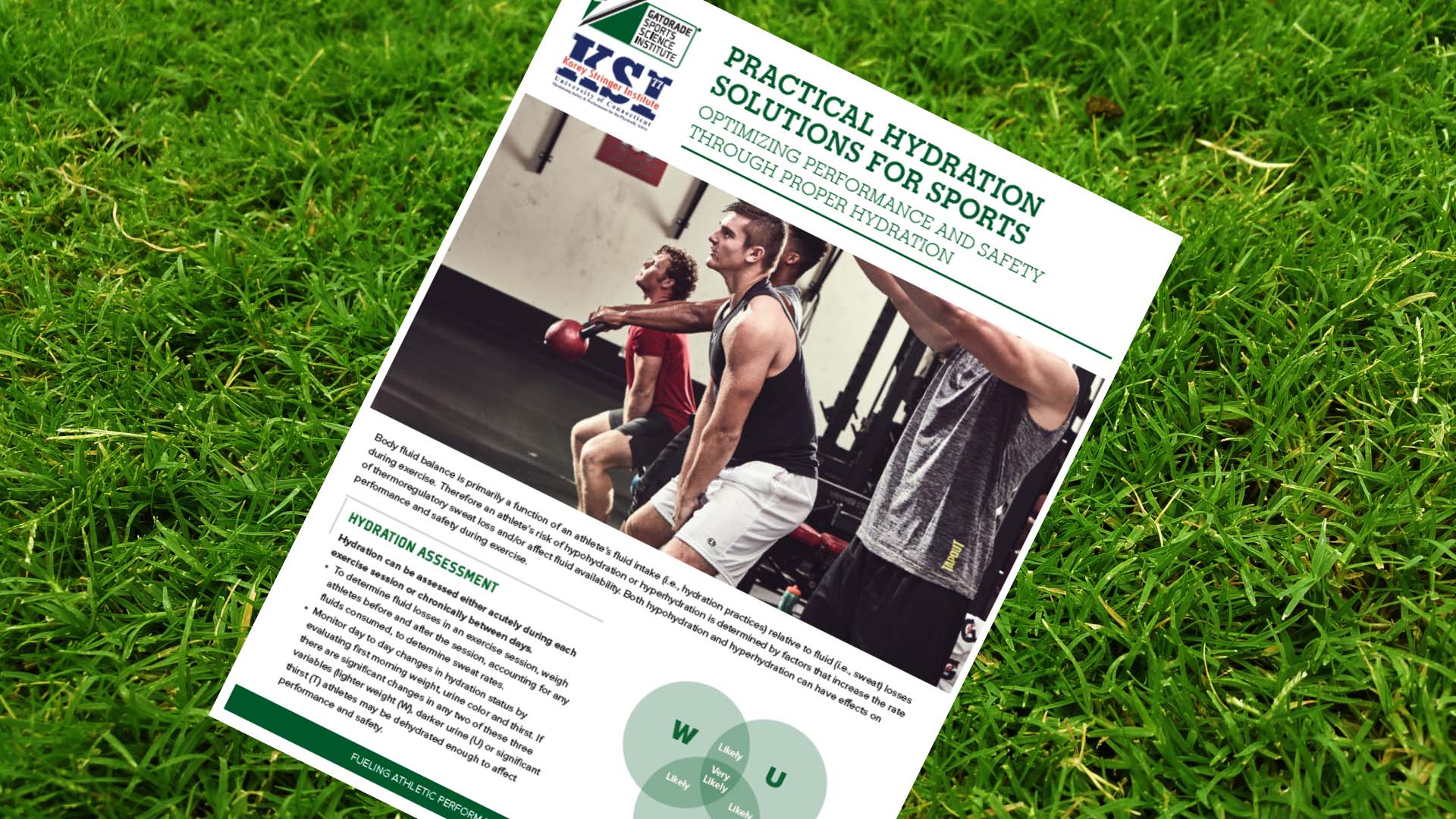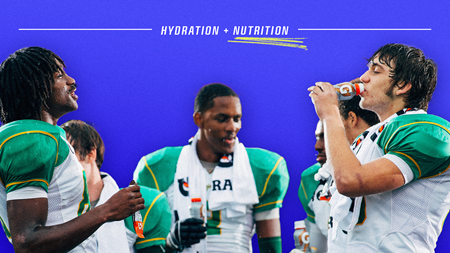Assessing an athlete's fluid intake relative to their fluid losses can show the profound effects both hypohydration and hyperhydration have on safety and performance. Exercise structure, environmental conditions, availability of fluids, intrinsic factors and sports-specific factors should all be weighed in during an athlete's hydration assessment.
Practical Hydration Solutions for Sports
Body fluid balance is primarily a function of an athlete’s fluid intake (i.e., hydration practices) relative to fluid (i.e., sweat) losses during exercise. Therefore an athlete’s risk of hypohydration or hyperhydration is determined by factors that increase the rate of thermoregulatory sweat loss and/or affect fluid availability. Both hypohydration and hyperhydration can have effects on performance and safety during exercise.
Hydration Assessment
Hydration can be assessed either acutely during each exercise session or chronically between days.
- To determine fluid losses in an exercise session, weigh athletes before and after the session, accounting for any fluids consumed, to determine sweat rates.
- Monitor day to day changes in hydration status by evaluating first morning weight, urine color and thirst. If there are significant changes in any two of these three variables (lighter weight (W), darker urine (U) or significant thirst (T) athletes may be dehydrated enough to affect performance and safety.

Exercise Structure
Exercise Intensity
- As the primary mechanism of heat dissipation, the evaporation of sweat is vital for regulating body temperature, even during temperate weather. However, sweating leads to fluid losses and increases the risk of hypohydration.
- Sweating rate is primarily a function of metabolic heat production, but modified by other factors such as environment and acclimatization status.
- Exercise intensity is the main factor that determines metabolic heat production, meaning that the rate of fluid losses from sweating increases with an increase in the intensity of the exercise.
Duration of Exercise
- Total fluid losses are the product of the sweating rate of a given exercise intensity and the total duration of that activity.
- In most circumstances there is an inverse relationship between the exercise intensity of a session and the duration of that session.
Continuous or Intermittent Exercise
- For sports like cycling and running, the influence of exercise intensity and duration on fluid needs is relatively easy to determine given the consistent nature of exercise.
- However, some of the most common sports (e.g., team sports) involve supramaximal exercise in short bursts with longer breaks. In this case, individuals should regard an overall average of exercise intensity rather than the maximal effort during the exercise bout when determining optimal fluid intake.
Number of Exercise Sessions Per Day
- When athletes undergo multiple exercise sessions in one day it is important to prevent losses from one exercise session impacting subsequent exercise sessions.
Environmental Conditions
At a fixed exercise intensity, the ambient environment dictates sweating rate.
Ambient Temperature, Humidity, and Wind
- The magnitude of evaporative, radiant, convective and conductive heat exchange between the body and the environment are a function of the gradients between the environment and the skin.
- Individuals exercising in hot, humid environments with direct sunlight and minimal airflow will experience near maximal sweating rates and be at the greatest risk of hypohydration.
- Wet-bulb globe thermometry (WBGT) accounts for these environmental factors and can help inform fluid replacement needs.
Altitude
- Very high altitude exposure tends to increase water and electrolyte losses and decrease plasma volume and total body water content.
- In both cold air and high altitudes, respiratory water losses may increase (due to low air water vapor pressures) and require additional fluid consumption.
- Athletes should acclimatize to altitude over several days and maintain euhydration prior to competition to ensure optimal athletic performance
Availability of Fluids
Fluid availability refers to the factors that dictate the capacity to replace fluid losses during activity.
Water Breaks
- Water breaks during training can be determined on the basis of work-to-rest ratios set by environmental conditions. Athletes should be given free access to fluid throughout the break.
- In many instances, the rules of the sport have a strong influence on the ability to drink during competition.
- An athlete’s drinking strategy for competition should be based on the ability to rehydrate within the rules of the particular sport.
- For example, in soccer and rugby, there are governing rules that limit the breaks in play. Therefore, an athlete’s opportunity to replace fluid losses is also very limited in these sports.
- In other examples (e.g. baseball, softball), there is essentially unlimited access to fluids during competition because of frequent rest breaks.
- In running road races, the International Association of Athletics Federations recommends that water stations are placed every ~5 km; however many races include more frequent stations. All athletes, but especially those taking part in endurance sporting events, should be educated on the risks of overdrinking (i.e., hyponatremia) as well as hypohydration.
- Athletes should practice their personal fluid intake strategy during training (ideally in competition-like conditions) before implementing into races/games.
Type and Temperature of Fluids Available
- Cool, flavored beverages should be provided, as these factors increase fluid palatability.
Intrinsic Factors
- Body Size: Heavier athletes produce and store more heat at a given absolute work rate (e.g., running velocity) than their lighter counterparts. Thus, larger athletes typically have higher sweat losses.
- Sex: Women may be at greater risk for exercise-associated hyponatremia during prolonged exercise (e.g. marathons and triathlons), and this risk has been attributed to their lower body weight and size, excess water ingestion, and longer racing times relative to men.
- Heat Acclimatization Status: Individuals who are heat acclimatized exhibit greater sweating rates, which can pose a greater risk of hypohydration.
- Thirst Drive: An individual’s thirst drive dictates how much they desire to drink, and is an important cue an athlete should heed. If they are thirsty, they are probably dehydrated, and should look to consume fluids. Conversely, though, the absence of thirst does not imply the absence of dehydration, which is why awareness of fluid needs is so critical.
Sport-Specific Factors
Clothing and Equipment
- Clothing and protective equipment provide insulation, which presents a barrier to heat loss, resulting in increased sweating rates to provide similar cooling to an unclothed situation.
- Sports/activities with specific clothing/uniform requirements, such as American football, are at greater risk of body fluid loss compared to activities in which clothing is minimal.
Weight Loss in Combat Sports and Appearance-Based Sports
- The culture and normal behaviors surrounding certain sports can greatly impact the hydration practices of athletes.
- In combat sports the practice of manipulating hydration status in order to meet body weight classifications is common.
- Sports where body image and appearance are emphasized (e.g. cheerleading and gymnastics), dangerous practices, such as extreme fluid restriction, may be used by athletes.
- In many cases athletes not only sacrifice their performance through these practices but also endanger their health and well-being.









